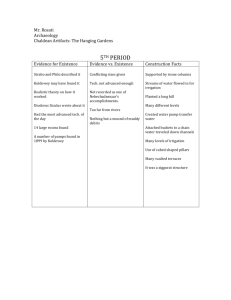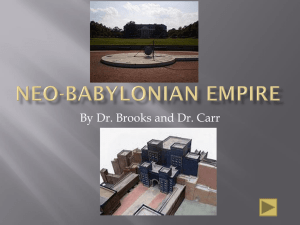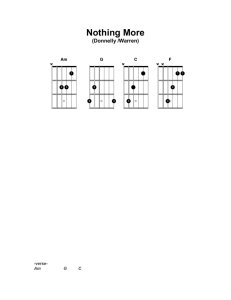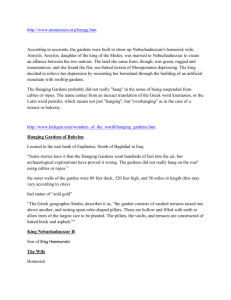Distribution and Abundance of Plants in
advertisement
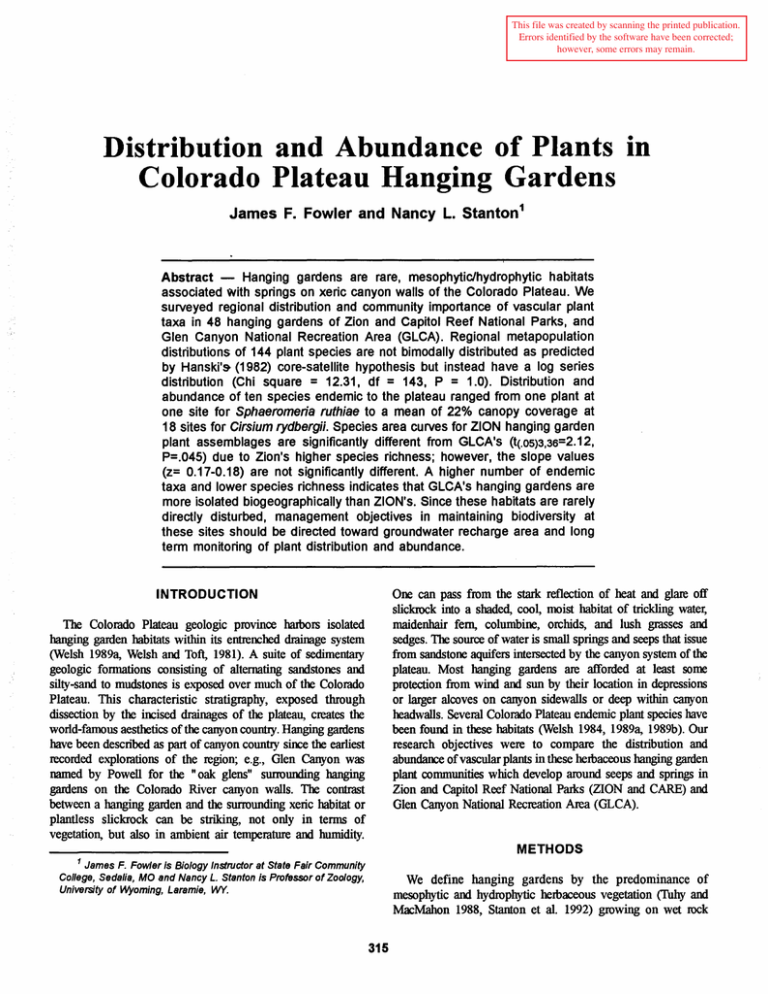
This file was created by scanning the printed publication. Errors identified by the software have been corrected; however, some errors may remain. Distribution and Abundance of Plants in Colorado Plateau Hanging Gardens James F. Fowler and Nancy L. Stanton 1 Abstract - Hanging gardens are rare, mesophyticlhydrophytic habitats associated with springs on xeric canyon walls of the Colorado Plateau. We surveyed regional distribution and community importance of vascular plant taxa in 48 hanging gardens of Zion and Capitol Reef National Parks, and Glen Canyon National Recreation Area (GLCA). Regional metapopulation distributions of 144 plant species are not bimodally distributed as predicted by Hanski's- (1982) core-satellite hypothesis but instead have a log series distribution (Chi square = 12.31, df = 143, P = 1.0). Distribution and abundance of ten species endemic to the plateau ranged from one plant at one site for Sphaeromeria ruthiae to a mean of 22% canopy coverage at 18 sites for Cirsium rydbergii. Species area curves for ZION hanging garden plant assemblages are significantly different from GLCA's (t(.05)3,36=2.12, P=.04S) due to Zion's higher species richness; however, the slope values (z= 0.17-0.18) are not significantly different. A higher number of endemic taxa and lower species richness indicates that GLCA's hanging gardens are more isolated biogeographically than ZION's. Since these habitats are rarely directly disturbed, management objectives in maintaining biodiversity at these sites should be directed toward groundwater recharge area and long term monitoring of plant distribution and abundance. One can pass from the stark reflection of heat and glare off slickrock into a shaded, cool, moist habitat of trickling water, maidenhair fern, columbine, orchids, and lush glaSses and sedges. The source of water is small springs and seeps that issue from sandstone aquifers intersected by the canyon system of the plateau. Most hanging gardens are afforded at least some protection from wind and sun by their location in depressions or larger alcoves on canyon sidewalls or deep within canyon headwalls. Seveml Colorado Plateau endemic plant species have been found in these habitats (Welsh 1984, 1989a, 1989b). Our research objectives were to compare the distribution and abundance of vascular plants in these hetbaceous hanging garden plant communities which develop around seeps and springs in Zion and Capitol Reef National Pruks (ZION and CARE) and Glen Canyon National Recreation Area (GLCA). INTRODUCTION The Colorado Plateau geologic province haIbors isolated hanging garden habitats within its entrenched drainage system (Welsh 1989a, Welsh and Toft, 1981). A suite of sedimentary geologic fonnations consisting of alternating sandstones and silty-sand to mudstones is exposed over much of the Colorado Plateau. This characteristic stratigraphy, exposed through dissection by the incised drainages of the plateau, creates the world-famous aesthetics of the canyon country. Hanging gardens have been described as part of canyon country since the earliest recorded explomtions of the region; e.g., Glen Canyon was named by Powell for the "oak glens" surroWlding hanging gardens on the Colomdo River canyon walls. The contrast between a hanging garden and the surrounding xeric habitat or plantless slickrock can be striking, not only in terms of vegetation, but also in ambient air tempemture and humidity. METHODS James F. Fowler is Biology Instructor at State Fair Community College, Sedalia, MO and Nancy L. Stanton is Professor of Zoology, University of ~oming, Laramie, WY. 1 We define hanging gardens by the predominance of mesophytic and hydrophytic hetbaceous vegetation (Tuhy and MacMahon 1988, Stanton et al. 1992) growing on wet rock 315 length to support linear hydrophytic plant communities in cracks and in narrow strips of wet, saturated soils. The vegetation is intennixed with thin sheet flow of water over wet rock surfaces. Ledge-soil complexes are composed of wet colluvial soils located just up slope of stabilizing ledges, including wet soil underneath an alcove. Since these soils develop directly from the weathering of sandstone, they are obviously very sandy and may be virtually saturated near seeps. Much of the characteristic herbaceous hanging garden vegetation is found on these wet colluvial soils. Seeplines are drier, linear microhabitats that develop at fractures in the sandstone or on impervious bedding planes on canyon walls and at the back of drier alcoves. Vrrtually all water in this microhabitat is used by the vegetation or lost to evaporation. Excess water for sheet flow on rock surfaces is not available. The distribution and areal extent of wet rock and colluvial soils on a garden depend on the physical attributes of the site including relative discharge of the seep or spring, facies characteristics, and location within the drainage. The resulting microhabitats fall into four major categories as listed in the methods section: wet wall, ledge, soil-ledge complex, and seepline. Regional distribution of the 144 species of vascular plants found on 48 hanging gardens in ZION, GLCA, and CARE fit a log-series distribution pattern (fig. 1) (Williains 1964 as cited in Krebs 1989) (Chi square = 12.31, df = 143, P = 1.0). In addition, the log-series pattern fits all within parle distributions (Chi square = 12.41-GLCA, = 7.17-ZION, = 1.76-CARE, P = 1.0). Most vascular plant species were found on only one or two sites; for example, 56 of the 144 species were found in only one hanging garden and 15 were found on only two. At the other extreme, only the maidenhair fern, Adiantum capillus-veneris, was found on most hanging gardens (47 out of 48). walls and on wet colluvial soils with moisture supplied by aquifer water via wide seep(s) (Stanton et al. 1992). They are apparently microciimatically isolated from the surrounding slickrock and xeric vegetation. Data collection on the physical pammeters of each hanging garden included mean aspect, elevation, size, and UTM coordinates. Measurements taken to detennine size were part of the vegetation sampling grid. Abundance of plant species was determined by Daubenmire (1959) canopy cover classes (1-6) using a 20 cm x 50 cm sampling frame. A systematic sample (n=10) with random starts (Manly 1989, Krebs 1989) was taken on each hanging ganlen microhatiitat accessible by non-technical climbing. Gardens were also searched for plant species which may not have been detected in quadrat sampling. Voucher specimens for each plant species present on each hanging ganlen were collected and identified by the staff at Rocky Mountain Herbarium in Laramie, WY. RESULTS Herbaceous hanging garden vegetation develops either directly in cracks on moist rock swfaces, or on colluvial soils supplied with subsoil moisture from the seep. Many seeps issue from the transition between the Navajo sandstone and the Kayenta Fonnation in these three parks. Others issue from impenneable facies within the Navajo sandstone. Each hanging garden was visually separated into the following microhabitats: wet walls, ledges, ledge-soil complex, and seeplines. Wet walls include slopes and floors covered with thin sheet flow of water as well as vertical walls and are dominated by ferns, prokatyotic and protistan communities. Ledges are of sufficient width and 144 species on 48 hanging gardens 60~----------------------------------------------------------~ F 50 r e q 40 U 30 e n 20 c y 10 o 10 30 20 47 Number of hanging gardens occupied Figure 1. - Histogram of hanging garden vascular plant species regional distribution in ZION and GLCA. 316 Table 1. - Plant species richness and physical parameters of hanging gardens in Zion National Park: size in m 2, aspect In degrees, elevation In ft., location in UTM coordinates. R Richness. = HanglngGarden Pine Creek Upper Emerald Lower Emerald Grotto Menu Falls Fall Falling Weter Narrows Trail Trail's End Canyon Overlook I Canyon Overlook II Court Patriarchs Snail Kaye's Weeping Rock Hailstone Table 2. - Size 1170 131 628 190 274 420 383 226 4 70 99 61 124 812 28 R Aspect 344° 120° 1582 1SO 218° 31° 318° 259° 303° 238° 124-242° 1n° 270° 192° 196° 100° 6 33 12 28 23 14 21 26 13 14 26 20 13 29 28 13 Elevation 4200 4700 4300 4600 4500 4500 4600 4500 4500 5250 5250 4750 4500 4600 4500 4700 UTM X UTM Y 325849.8 326061.4 326166.9 327434.5 324416.6 328178.1 326982.4 327489.1 327397.1 327979.7 327878.7 325531.3 327713.9 327134.3 328346.6 327052.6 4120485.0 4125225.0 4124882.0 4124914.0 4127546.0 4126268.0 4123753.0 4128541.0 4128715.0 4120384.0 4120338.0 4123556.0 4127987.0 4126287.0 4126609.0 4126318.0 Plant species richness and physical parameters of hanging gardens in Glen Canyon National Recreation Area: size in m 2, aspect In degrees, elevation in feet, location in UTM coordinates. R Richness. HangingGarden Dune Crossbed Rattle-sna ke Hardwood Pedestal Zephyr Graffiti Upper Three Lower Three Surprise Ivy Baby Baby Too Zigy Hook Hawk Swallow Ice Comer Channel Barbara Marla Stone Basin Wrong Boon-doggle Camp Pyro = Size 173 115 836 11n 269 81 44 825 162 150 70 35 38 1215 351 193 52 893 249 714 344 86 115 35 17 341 37 R 18 22 20 29 15 16 7 15 6 9 7 10 10 30 27 12 11 18 13 11 21 14 16 11 11 19 21 Aspect 90° 201° 356° 155° 160° 174° 175° 230° 230° 120° 233° 263° 205° 186° 212° 243° 7° 238° 112° 156° 60° 138° 109° 195° 5° 202° 317 Elevation 4000 4040 3800 3840 3800 3800 3800 4100 3840 3880 3840 3760 3920 3880 4160 4160 3880 4050 4050 3920 3980 3850 3950 3840 3800 3800 3800 UTM X 525718.3 525855.6 525142.8 526840.1 511965.1 512511.3 512332.5 510509.6 510372.5 527149.5 527418.3 527633.3 527706.3 514304.1 515549.0 516034.8 514926.3 526533.3 526583.3 526583.4 506610.6 505060.1 505925.5 504665.9 538226.2 537350.4 568255.1 UTM Y 4124789.0 4124822.0 4122410.0 4125133.0 4127387.0 4127486.0 4127398.0 4116716.0 4116613.0 4125485.0 4125696.0 4125514.0 4125909.0 4123519.0 4123938.0 4122757.0 4122935.0 4127594.0 4127625.0 4127412.0 4139277.0 4139649.0 4141012.0 4139096.0 4159463.0 4158251.0 4159430.0 distnbution records for the species and for GLCA. They are isolated locations in Pictograph, Ribbon, and Knowles Canyons respectively which show little, if any, sign of visitation Each of the stands had many individual plants of this species and appear to be vigorous. Disjunct populations of American spikenard, Aralia racemosa, and cliff jamesia, Jamesia americana var. zionis, were found on two ZION hanging gardens: Falling Water and Grotto. American spikenard had an 8% average canopy cover on ledge microhabitats as well as several individual plants on both hanging gardens. Cliff jamesia had much fewer individuals and did not show up in community samples. Zion tansy, Sphaeromeria ruthiae, was collected only at Falling Water HG. This rare species is endemic to Washington County and previously noted only in ponderosa pine communities (Atwood et aI. 1991). At the other extreme are a few hanging gardens in GLCA such as Hawk HG (Table 3) in which the endemic Rydberg thistle, Cirsium rydbergii, covered almost all of the vegetated surface over large parts of the hanging garden. Plant species richness varied from 6-30 per site while size varied from 4 to 1215 m2 (Tables 1, 2). The area-species relationships (MacArthur and WIlson, 1%7), S =cAZ where S = number of ~ies, A = area, are S = 0.889A.l7 for ZION and S = 0.733A· 1 for GLCA where S is species richness and A is area of each hanging garden (fig. 2). The slopes (z) of the two regression lines (.17 vs .19) are not significantly different (t(.OS)2,39 = 2.02, P >.50). However, the constant values (0.889 vs .733) are significantly different (t(.OS)2,36 = 2.12, P = .04) primarily due to the higher average number of species per hanging garden in ZION. The area-species relationship for CARE was not calculated due to small sample size (n = 5). We have analyzed the distribution and community importance of endemic taxa, disjunct pop'ulations of more widespread species, and possible endangered species (Table 3). Federal and state status was taken from Atwood et al. (1991). Quantitative measurement of hanging garden vegetation communities indicates that maidenhair fem, Adiantum capillus-veneris, the most widely distributed hanging garden species on a regional basis, was also the most abundant species in wet wall and seepline microhabitats in most hanging gardens. Grasses, especially Jones reedgrass, Calamagrostis scopulorum, and sedges, Carex, tended to be abundant on ledge and ledge/soil complex microhabitats. Zion daisy, Erigeron sionis, was found on only two hanging gardens in ZION as a vety small part of the community canopy coverage. There are, however, many individual plants on the wet wall at Canyon Overlook IT HG within one meter of the trail on which thousands of tourists walk each year. Alcove bog-orchid, Habenaria zothecina, was found on wet ledge/soil complex microhabitats on four hanging gardens in GLCA where it occupied 2-5% of the canopy. Three hanging gardens have a north aspect (Table 3): Rattlesnake-356°, 0 Swallow-~, and Camp-5 • These sites represent new Log (s) DISCUSSION Regional species distribution patterns have often been descnbed as log series (Williams, 1964) or .lognormal (May, 1975) for many different taxa. A recent hypothesis fonnulated by Hanski (1982) predicts a bimodal distribution pattern for similar sites within a region: a mode of rare species found at few sites, a mode of abundant species found at most sites, and vety few species found at a moderate number of sites. Our distribution patterns did not support the bimodal pattern of Hanski's (1982) core-satellite hypothesis. Hanging garden vascular plants have a log series distribution pattern with many species found at only a few sites. Many of these are transients =.171og (A) + .88 Log (s) = .19 log (A) + .73 1.6 Log (species richness) o Zion NP ... Glen Canyon NRA 1.4 1.2 o 0.8 o 0.6-=-• • • • • • • • • • • • • • • • •. " o 0.5 1.5 2 2.5 3 3.5 Log (area in sq. m 2) Figure 2. - Area-Species relationship linear regressions for ZION and GLCA hanging garden vascular plant species. 318 Table 3. - Protection status and average canopy coverage values for hanging garden vascular plants with narrow distributions: * species endemic to Colorado Plateau, ( ) coverage range, T trace, [ ] sample size. Microhabitat symbols: ww wet wall, I = ledge, Is = ledge/soil, sl = seepline. Note: Carex sp. values not separable by species but ranged from (T-.37). = = = = = Microhabitat Status Species Jamesia americana zionis Fed St C2 G5T1 ww sl T [2] 151 *Habenaria zothecina C2 G1 151 .05 [1 ] *Erigeron sionis C2 G2 152 .01 (T-.01 ) [2] *Carex curatorum Is .10 (T-.26) [3] - T [1 ] I G5Q [8] 151 *Carex haysii [5] Aralia racemosa Dodecatheon pulchellum zionense *Sphaeromeria ruthiae .03 (.03-.04) [3] C2 G2 152 .08 (T-.15) [3] .04 .11 (.08-.13) [3] .20 (.06-.35) [8] [1] T [1 ] *Zigadenus vagnatus .13 [1 ] Rubus neomexicanus .04 [2] *Cirsium rydbergii .03 (T-.13) .05 [1 ] .22 (T-.79) [14] .037 [1 ] .063 [1 ] [7] Cladium califomicum *Primula specuicola .01 (T-.08) [8] .07 (.03-.15) [3] .02 (.02-.03) [5] *Mimulus eastwoodiae .08 (T-.2O) [5] T T *Aquilega micrantha .10 (.01-.20) [4] T [1 ] .01 (T-.02) [2] .03 (T-.06) [9] (Houle, 1990), and 0.59 in Oklahoma (Uno and Collins, 1987). Additionally, B~nd et al. (1988) found a Z value of 0.43 for fynbos shrub lands surrounded by Afrotemperate evergreen forests in South Africa In this context, our Z values are more continental. The 56 species which occurred in only one hanging garden (fig. 1) also supports MacArthur and Wilson's (1967) hypothesis that habitat islands receive large numbers of propagules from adjacent mainland areas. Many Colorado Plateau endemic species found in hanging gardens are widespread regionally within the hanging garden habitat. In addition, Rydberg thistle and Zion shooting star can be locally abundant within a hanging garden It is the habitat from nemby xeric or riparian vegetation and probably not a stable component of hanging garden species assemblage. Other rare species such as Alcove bog orchid and Zion daisy are restricted to hanging gardens and seeps and should be monitored for population size changes. The area-species relationship Z values for ZION (0.17) and GLeA (0.19) are intennediate to MacArthur and Wilson's (1967) predicted values for continental (0.l2-O.17) and island (0.20-0.35) biota. While these intermediate values for insular continental areas were also predicted by MacArthur and Wilson (1967), empirical studies of plants on soil islands in granite outcrops have found higher values: 0.566 in the Southeast U.S. 319 MacArthur, R. H.; and Wilson, E. O. 1967. The Theory of Island Biogeography. Princeton Univ. Press, Princeton, NJ Manly, B. F. 1. 1989. StIatified and systematic sampling. Unpub. ms., ver 11-89. May, R. M. 1975. Patterns of species abundance and diversity. In: M. L. Cody and J. M. Diamond (eds.) Ecology and Evolution of Communities, pp. 81-120. Belknap Press, Harvard University, Cambridge, MA. Stanton, N. L.; Buskirk, S. J.; am Fowler, J. F. 1992. Anrual Report for Biogeography of Invertebrates of t:re Colorado Plateau. unpub. ms. UW-NPS Research Center, Lanunie, WY. Tuhy, 1.L.; and MacMahon J. A. 1988. Vegetation and Relict Communities of Glen Canyon National Recreation Area, Final Report for contract CXI200-6B076. Uno, G. E.; and Collins, S. L. 1987. Primary succession on granite outcrops in southwestern Oklahoma. Bull. Torrey Bot. Club 114:387-392. Welsh, S. L. 1984. Flora of Glen Canyon National Recreation Area, unpub. ms. _ _- - 1989a. On the Distribution of Utah's Hanging Gardens. Gt. Basin Nat. 49:1-30. _ _ _ _ 1989b. Hanging gardens of Zion National Park, Final report NPS contract CXI590-7-0001. _ _ _ _ and Toft, C. A. Biotic communities of hanging gardens in southeastern Utah. Nat. Geo. Soc. Res. Report 13:663-681. Williams, C. B. 1964. Patterns in the Balance of Nature. Academic Press, London that is rare and fmite. Except for Weeping Rock hanging garden at ZION, these hanging garden habitats are rarely impacted by human visitation Since the first requirement for hanging garden existence is the presence of a perennial seep, conservation priorities should be placed on managing the Navajo sandstone aquifer and its recharge areas. LITERATURE CITED I Atwood, D.; Holland, 1.; Bolander, R; Franklin, B; House, D; Annstrong, L; Thorne, K; and England, L. 1991. Utah Endangered, Threatened, and Sensitive Plant Field Guide. Utah 'lES Plant Interagency Committee. Bond, W. 1.; Midgley, J.; and Vlok, J. 1988. When is an island not an island? Insular effects and their causes in fynbos shrublands. Oecologia 77:515~521. Daubenmire, R. 1959. A canopy-coverage method of vegetational analysis. Northwest Science 33:43-64. Hanski, I. 1982. Dynamics of regional distribution: the core and satellite species hypothesis. Oikos 38:210-221. Houle, G. 1990. Species-area relationships during primary succession on granite outcrop plant communities. Amer. J. Bot. 77: 1433-1439. Krebs, C. 1. 1989. Ecological Methodology. Harper & Row, Publishers, New Yolk. 320

